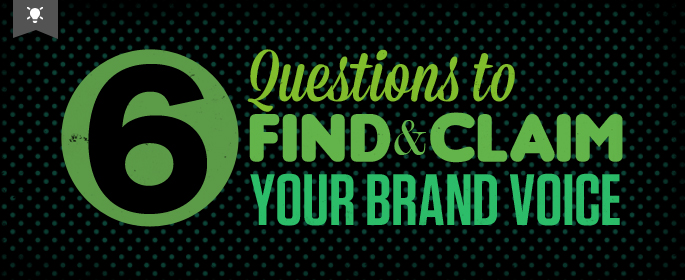
It happens like clockwork. A client signs on to the idea of creating a blog, investing in a content marketing campaign, starting a new social media program or rewriting the bulk of their website and a look of panic begins to overtake their body. It’s not panic over what they’re going to write. They know how to use content marketing tools to identify that (or that we’ll do it for them). They’re worried about how they should say it.
It’s an insecurity about their voice.
Before content was given respect and before social media gave brands a microphone, it was easier to hide behind a generic brand voice. But today, that simply doesn’t fly. You need a strong, branded voice to assert yourself in a crowded market, to get attention and to tie people to your brand.
But how do you create one?
Below you’ll find a short list of the questions we use to help our clients find the right voice to attract and sell to clients.
1. Who is your audience?
Are they male or female? Are they conservative or do they like to push the boundaries? What type of language do they use on social media, in support emails to your team or during in-store face-to-face conversations? Who do they value and look up to? What are they looking for?
Or, here’s a simpler question: If your customer was asked to explain your product or service to a third-party, what would he or she say? What words would they use? What attitude would they take?
It’s tempting to look inward when deciding on your voice but I always prefer to start by looking out. Your customers, their comfort levels and the things they want in you will help you decide upon the voice you need to take to get their attention. Collect a good profile.
2. What is your desired emotional aftertaste?
Back in 2006, Ze Frank defined “brand” as an emotional aftertaste conjured up by a series of experiences. He said a person will immediately have a feeling or image conjured up when they heard the word “grandma.” A bunch of experiences created that brand, “like making good cookies. And tucking you in. And chasing you under a table when you called your uncle an alcoholic.”
Why is creating an emotional aftertaste for your brand so important? Ze told us all the way back in 2006.
He said:
Because right now, platforms are fracturing. There are fewer specific places that have access to a large market share. It’s getting harder to speak to lots of people.
But the shared emotional aftertaste of brand is platform-independent. If you leverage those aftertastes, people will pay attention, regardless of where they are. And whether the emotional aftertaste is good or bad is irrelevant! As long as they’re watching.
That.
Yes, that! It doesn’t matter if your brand is as sweet as your grandma or as polarizing as a company that hates fat people, as long as it’s an aftertaste that makes them tune in and watch. As long as you leave them with something to take when they go.
What is your emotional aftertaste? What feelings do you want to inspire?
3. What are your key brand tenets?
Sometimes to understand your emotional aftertaste, you need to first identify your key brand tenets. These are the small collection of things your brand truly believes in. They’re the things you won’t comprise on because they’ve lasted the test of time and they’re what people expect and love about you. They’re your core values.
- Maybe you’re a fitness center with a focus on the whole body, not just the number on the scale.
- Or you’re a private school that focuses on leadership and morality.
- Or you’re a digital marketing agency with a rebellious streak.
- Maybe you’re a collision company that only uses superior parts. Or gives employees the opportunities to train for special certifications.
If there’s any question about what your values are – hell, even if there isn’t any question – poll your team. Ask your executives, the person who empties your garbage, the girl that answers the phone and the guy who updates your Facebook. Read their answers and see what they’re saying and if they’re the same. It’s a good exercise for most brands.
All brands have a small list of tenets they hold close to their heart. What are yours and how can you put them to the front of your marketing efforts?
4. What are your key messages?
Built from your brand tenets are your key messages. These are the themes or statements most important to sharing the benefits and values of your brand. Attached to each singular statement are proof points and attributes that help reinforce this message and how it applies to your brand.
For example:
Key Message: [Brand Name] values its customers, employees and community to the highest level.
Proof Point: [Brand Name] believes community starts at home and puts service at the core of its business.
Attribute: For the past 25 years, [Brand Name] has donated 20 percent of its billable time to providing free services for local businesses.
We hear the overarching messaging, we see what that means day-to-day and we see specifics as to how they live it.
The value of creating these messaging statements is (a) it forces you to identify what they are and (b) a record is created to share with current and new staff so everyone is living by the same messaging.
5. What angers you about your industry or your competitors?
We don’t get mad about something unless we’re passionate about it and believe it should be done differently.
- I become angry when marketers take advantage of small business owners by selling them websites that look pretty, but are functionally void of value.
- I get angry when businesses use their social media accounts to look like drunk toddlers. Or when they wish your cat a happy birthday and consider that “influencer engagement.”
I get angry about these things because proper use of social media and empowering small business owners are elements I am very passionate about.
Do you remember the last time you were fuming at your industry? Why were you so mad?
6. Where are your limits?
In a perfect world, your brand would be a perfect reflection of who you are and what you believe. But unfortunately, most of us have customers or clients or colleagues or dreams of a social life. That means we can’t always wear our hearts or our brands on our sleeve.
If you’re leaning toward a more informal, maybe controversial brand, be sure to create limits BEFORE you find yourself in hot water.
- How far are you willing to go?
- How much will you polarize to target your audience?
- What topics will you stay away from completely?
Know. And know now.
Claiming Your Voice
The purpose of the elements above are to help you understand your customer, your place in the market, your values and what you stand for as a brand. Once you’ve determined them, you must commit to bleeding them.
And that can be a problem for many brands who are fearful of putting themselves out there. I understand. But do it anyway.
It might feel awkward at first. You might feel vulnerable. But once the right customer is being attracted to the right message, you’ll see the power.
And once you decide on a voice to represent your brand – note it. Create a Brand Positioning Document to share internally and with all new hires to everyone knows the proper way to represent the brand, both online and off.





